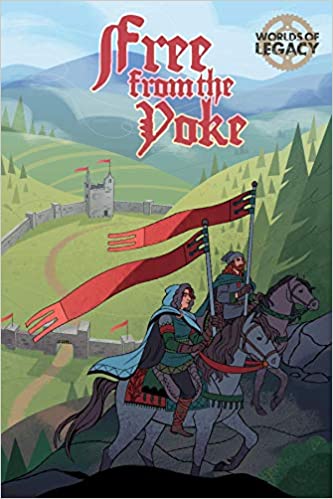I started to feel that I didn’t know roleplaying games well enough so I came up with the plan to read a roleplaying game corebook for every year they have been published. Selection criteria is whatever I find interesting.

The first time I encountered the idea that you’d play both a kingdom or a similar political entity and an individual character was in the AD&D 2nd Edition setting Birthright. Instead of looking at the world from the eye-level of a single person, you had the top-level view on which wars were decided and grand political strategies enacted.
Free From the Yoke is based on a similar idea. The land has been freed from occupation by the Empire and its time for its people and institutions to figure out how to manage their own affairs. The game draws inspiration from East European history, specifically the period when much of the area was under Mongol rule and its aftermath. You could do a similar game in a more modern setting as well, for example in Iraq after American occupation.
The impressive thing about Free From the Yoke is that it’s just filled to the brim with design. The nuances of different character types, moves, playable factions… All have been designed to within an inch of their lives.
One interesting detail is that the GM has an in-game presence in the form of the Arbiter, the force that finally led the people and the land to independence. The Arbiter is a complex force, not necessarily always good now that it is a time of peace. There are three possible Arbiter playbooks for the GM, the same as there are character and faction playbooks for the players.
There are two ways to approach setting design in roleplaying games, systemic and handcrafted. A handcrafted setting is detailed in the book. We’ll know who the important people are, what are their names, which factions they belong to. One advantage this approach has is that it creates a common culture of reference points between different groups that play the same game.
A systemic approach codifies the essentials of the setting into system elements, so that as players engage with the game, a playable setting is produced. Different groups playing the same game will have different settings, just featuring some commonalities. This is the approach taken by Free From the Yoke, a very system-oriented game where the specific contours of play are actually a little difficult for me to imagine based on just reading the book.
One of the stranger choices is to leave the Empire, the former occupying force, quite faceless. It’s culture doesn’t seem to have affected the people or the land much at all despite long occupation in terms of lasting cultural changes. To grasp those, it feels like we’d need to know what the Empire was like. Of course, I’m reading this from the perspective of a Finnish person. Finland used to be ruled first by Sweden and then Russia, and both left their mark.
This is one of the best games I’ve read during this project. It felt original, very well designed and fresh in its vision.